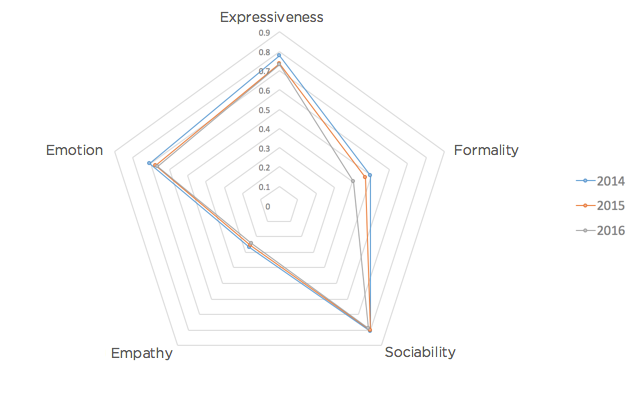Brands
5 Factors That Could Impact Your Content Strategy in 2017
Nobody wishes you luck unless you’re an underdog. In Hollywood, our favorite protagonists like Rocky, Luke Skywalker, and Elle Woods all hear words of encouragement from friends and mentors before they take on a crucial challenge. But wishing someone luck also comes with the understanding that these protagonists may fail. (The subtext: Good luck because you’ll need it.)
However, those protagonists didn’t really need luck. When we break down their victories, we can see that they channeled all of their effort into preparing a strategy that would help them be successful.
Such preparation applies to everything from boxing to intergalactic warfare to content marketing. (You saw where this was going.) As brands increase their content investments, it will only get harder for them to outperform competitors. B2B brands already spend an average of one-third of their marketing budgets on content. In 2017, 39 percent of brands plan to increase this investment, making it that much harder to separate yourself and drive ROI.
As companies prepare to kick off their content programs in 2017, it’s important to look at the strategic levers that could impact their investments. Since luck will only get you so far, here are five factors to consider for the upcoming year.
Don’t underestimate infographics
Brands tend to fixate on blog posts—and for good reason: Text articles are an efficient way to communicate complex ideas and expertise. With the right research and tone, they can be an important differentiator for brands. However, if you invest too heavily in text, you miss out on the opportunity to stand out by trying other mediums.
When Contently’s data scientists dug into the numbers from over 3,200 pieces of client content, the results were surprising. Infographics reached 54 percent more people than blog posts. Not only did they reach more people, but the median cost to reach one reader was significantly cheaper—$0.04 for infographics versus $1.77 per blog post. Infographics also had a 73 percent completion rate while blog posts hovered around 66 percent. The largest percentage of infographic traffic came from “internal” sources, which means audiences were coming to this type of visual content after previously poking around on a site.
This doesn’t mean you should abandon blog posts. The lesson here is to think about how infographics can enhance the user experience for your audience. While infographics may, depending on the design, cost more to produce upfront, their effectiveness often makes them a savvier investment.
What happens inside downloadable content matters
Let’s say you’re developing an e-book with a $4,000 budget that will cover the costs of freelance talent, social distribution, and email and webinar campaigns. Your marketing team will probably measure the e-book’s ROI by looking at clicks, leads, and sales generated by signups from the gated form.
If you’re an executive, you’re interested in those end results. But for the people focused on content creation or marketing distribution, these triggers don’t reveal much about which parts of the asset resonated most with readers. What topics garnered the most attention and highest engagement rates? What pages did people return to or skip over?

The next step in the evolution of downloadable content is to understand exactly what happens when someone reads that e-book. This insight will give more context to those high-level ROI metrics. At Contently, we use our Document Analytics tool to look at engagement on a granular level by tracking time spent per page and relying on heat maps for clicks and mouse placement.
Tech should support your editorial workflow
A workflow moves a piece of content from ideation to publication. We recently wrote about why workflows are vital to the editorial process, ensuring quality remains high while limiting unnecessary bureaucracy. The big difference in 2017 will be the way brands capitalize on technology to enable this process.
Instead of waiting for a vague email from the next person in the chain of command, workflows managed on one platform will allow each person to clearly understand her step in the production process—with attached deadlines to hold people accountable. At Contently, I know a writer will be knocking at my door if I sit too long on a story. The same goes if I have to get an image approved by design.
While we often think about technology taking the human element out of processes, it can have the opposite effect. The right technology brings order to the publishing process, freeing humans to do what they do best: create.
Algorithms will redefine talent selection
While most brands know which topics they want to cover and how much they want to spend, finding the right contributors for a content program can be overwhelming. On the Contently platform alone, there are over 100,000 freelancer profiles. That’s why our data science team realized the only scalable and sustainable way to pair brands and freelancers was to build an algorithm that could act as matchmaker.
After the data science team combed through thousands of talent profiles, using algorithms to search for key SEO terms and parsing them out by industry and topic, it became much easier to narrow down which contributors would be best suited for particular publications. (From here, contributors can also be filtered by location and experience.)
Aside from reducing the time it takes to complete an assignment, talent algorithms can help ensure you find the person who is the best fit for a specific job, something that will be crucial in 2017 as more companies pursue content marketing.
Tone analysis is important for brand governance
Tone isn’t just about deciding what to sound like or a tool to differentiate a brand from industry competitors—it becomes a mechanism to ensure content remains on-brand.
On TCS, we’ve started using an internal tone analyzer to track this consistency. The site’s tone has remained steady over the last three years, even as we’ve brought on new writers and editors.

This doesn’t mean our posts lack diversity. A piece on Facebook Live is very different from a story about headlines. We’ve just had a reliable balance of different voices and perspectives, all while making sure our coverage stays within the confines of our long-term strategy.
The big takeaway here is there’s no magic fix that will make you a great content marketer. A little luck won’t hurt, but to succeed in 2017, you’ll have to plan ahead and, ultimately, make sure you’re supported by the right tools and strategy.
Image by Mike Kemp / GettyGet better at your job right now.
Read our monthly newsletter to master content marketing. It’s made for marketers, creators, and everyone in between.




